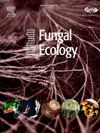Does ectomycorrhizal fungal biodiversity affect tree growth?
IF 2.2
3区 环境科学与生态学
Q3 ECOLOGY
引用次数: 0
Abstract
Ectomycorrhizal fungi (EMF) are ubiquitous tree-associated symbionts aiding plant nutrition and growth in forests from the tropics to the boreal zone. They colonize tree roots and provide >70% of growth limiting nutrients, but with >10,000 EMF species, tree growth rates may vary depending on the composition and diversity of associated EMF communities as a consequence of the diversity of fungal functions and niches. While ample research demonstrates that EMF species differentially influence host plant growth in experimental inoculation studies, disparate insights from experimental and observational studies in the field must be integrated to evaluate the ecological relevance of EMF species, compositional, and biodiversity differences. In this short review, I evaluate whether EMF species identity, composition, and richness affect tree growth during early plant life stages. I first show that EMF species often, but not always, differentially effect seedling and sapling growth, both in the greenhouse and under field condition where other factors determine plant growth, such as variation in soil fertility and climate. Effects of EMF species richness on plant growth are context dependent, and stimulated tree growth in 37% of the cases identified (11/30 cases). Evidence to date suggests that differences in EMF composition more than richness affect tree growth. Limitations of current experimental studies and challenges interpreting observational patterns make it difficult to tease apart causality and directionality, but I provide a list of possible solutions for future research to address outstanding questions. Understanding how mycorrhizal biodiversity affects plant growth is not only an important frontier in ecological research, it also has implications for embedding fungi into forest management, conservation, and ecosystem restoration agendas.
外生菌根真菌生物多样性影响树木生长吗?
外生菌根真菌(EMF)是普遍存在的与树木相关的共生体,有助于从热带到北方地区森林中的植物营养和生长。它们定植在树根上,并提供70%的生长限制养分,但由于真菌功能和生态位的多样性,在10,000种EMF物种中,树木的生长速度可能会根据相关EMF群落的组成和多样性而变化。虽然大量研究表明,在实验接种研究中,EMF物种对寄主植物生长的影响是不同的,但必须将来自该领域实验和观察研究的不同见解整合起来,以评估EMF物种、组成和生物多样性差异的生态相关性。在这篇简短的综述中,我评估了EMF物种的特征、组成和丰富度是否会影响植物早期的生长。我首先表明,电磁场物种经常(但并非总是)对温室和田间条件下的幼苗和树苗生长产生不同的影响,在其他因素决定植物生长的条件下,如土壤肥力和气候的变化。EMF物种丰富度对植物生长的影响依赖于环境,在已确定的案例中,有37%(11/30)的案例刺激了树木生长。迄今为止的证据表明,EMF组成的差异比丰富程度的差异更能影响树木的生长。当前实验研究的局限性和解释观察模式的挑战使得很难梳理出因果关系和方向性,但我为未来的研究提供了一个可能的解决方案清单,以解决悬而未决的问题。了解菌根生物多样性如何影响植物生长不仅是生态学研究的重要前沿,而且对将真菌纳入森林管理、保护和生态系统恢复议程具有重要意义。
本文章由计算机程序翻译,如有差异,请以英文原文为准。
求助全文
约1分钟内获得全文
求助全文
来源期刊

Fungal Ecology
环境科学-生态学
CiteScore
5.80
自引率
3.40%
发文量
51
审稿时长
3 months
期刊介绍:
Fungal Ecology publishes investigations into all aspects of fungal ecology, including the following (not exclusive): population dynamics; adaptation; evolution; role in ecosystem functioning, nutrient cycling, decomposition, carbon allocation; ecophysiology; intra- and inter-specific mycelial interactions, fungus-plant (pathogens, mycorrhizas, lichens, endophytes), fungus-invertebrate and fungus-microbe interaction; genomics and (evolutionary) genetics; conservation and biodiversity; remote sensing; bioremediation and biodegradation; quantitative and computational aspects - modelling, indicators, complexity, informatics. The usual prerequisites for publication will be originality, clarity, and significance as relevant to a better understanding of the ecology of fungi.
 求助内容:
求助内容: 应助结果提醒方式:
应助结果提醒方式:


